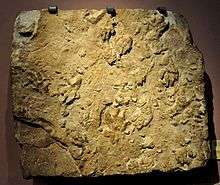Chirotherium
Chirotherium, also known as Cheirotherium (‘hand-beast’), is a Triassic trace fossil consisting of five-fingered (pentadactyle) footprints and whole tracks. These look, by coincidence, remarkably like the hands of apes and bears, with the outermost toe having evolved to extend out to the side like a thumb, although probably only functioning to provide a firmer grip in mud. Chirotherium tracks were first found in 1834 in Lower Triassic sandstone (Buntsandstein) in Thuringia, Germany, dating from about 243 million years ago (mya).
| Chirotherium | |
|---|---|
| Cheirotherium trace fossil, displayed in Oxford University Museum of Natural History | |
| Trace fossil classification | |
| Kingdom: | Animalia |
| Phylum: | Chordata |
| Class: | Reptilia |
| Ichnofamily: | †Chirotheriidae |
| Ichnogenus: | †Chirotherium Kaup, 1835 |
| Type ichnospecies | |
| C. barthii Kaup, 1835 | |
| Ichnospecies | |
| |
| Synonyms | |
The creatures who made the footprints and tracks were probably pseudosuchian archosaurs related to the ancestors of the crocodiles. They likely belonged to either prestosuchidae or rauisuchidae groups, which were both large carnivores with semi-erect gaits.
History

Chirotherium tracks were first found in German Triassic sandstones in 1834, and later in England in 1838. They were found before dinosaurs were known and initial models of the trackmaker proposed that it was a bear or ape, which walked with its feet crossed.[1] This proposal was necessary to explain the toe on the outside. The tracks were also proposed to be from a marsupial.[2] These fossil tracks have now been found on North America, Argentina, North Africa, Europe, and China.
British paleontologist Richard Owen suggested in 1842 that the tracks were made by a labyrinthodont amphibian.[2] Over the following years, new discoveries of archosaurian reptiles indicated that Chirotherium tracks were made by a pseudosuchian. The print’s resemblance to mammals was only superficial; in reality, an external (lateral) ‘thumb’ was commonplace among Triassic archosaurs.

In 1965, the skeleton of an animal probably closely related to the trackmaker of Chirotherium was found, called Ticinosuchus.[2] It had the external toe on its hind feet but not on its front feet and was possibly a more derived descendant, whose gait did not require a stabilizing front toe. Footprints of different size and proportions occurring together on one and the same bedding plane probably reflect a gender difference (sexual dimorphism) within the trackmaker species.[3]
Other Chirotheriidae include Isocheirotherium.
Paleobiology
Chirotherium trackways have been found in German sandstones that were likely deposited on flood plains. During the Middle Triassic, much of Central Europe was covered by a shallow epicontinental sea (the so-called Muschelkalk Sea). In one location, Chirotherium trackways were found alongside those of early horseshoe crabs. The horseshoe crabs were likely breeding along the intertidal zone while the Chirotherium trackmaker preyed on them during low tide. Smaller reptiles like Macrocnemus, represented by the ichnogenus Rhynchosauroides, likely fed on the horseshoe crabs’ eggs.[4]
See also
References
- Swinton, W.E. (1961). "The history of Chirotherium". Geological Journal. 2 (3): 443–473. doi:10.1002/gj.3350020309.
- Bowden, A.J.; Tresise, G.R.; Simkiss, W. (2010). "Chirotherium, the Liverpool footprint hunters and their interpretation of the Middle Trias environment". Geological Society, London, Special Publications. 343: 209–228. doi:10.1144/SP343.12.
- Tresise, G. (1996). "Sex in the footprint bed". Geology Today. 12 (1): 22–26. doi:10.1046/j.1365-2451.1996.00005.x.
- Diedrich, C.G. (2011). "Middle Triassic horseshoe crab reproduction areas on intertidal flats of Europe with evidence of predation by archosaurs". Biological Journal of the Linnean Society. 103 (1): 76–105. doi:10.1111/j.1095-8312.2011.01635.x.